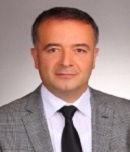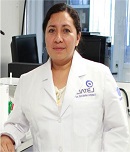Day 2 :
Keynote Forum
Ufuk Yildiz
Kocaeli University, Turkey
Keynote: Novel macroporous cryogels with enhanced adsorption capability for the removal of Cu(II) ions from aqueous phase: Modeling, kinetics and recovery studies
Time : 09:45-10:10

Biography:
Ufuk Yildiz studied Chemistry at the Karadeniz Technical University and has done his PhD in 1998 supervised by Professor Baki Hazer. He joined at the Kocaeli University as an Assistant Professor in 1998. After his Post-doctoral work on miniemulsion and emulsion polymerization with Professor Markus Antonietti, Dr. Katharina Landfester and Dr. Klaus Tauer at Max Planck Institute of Colloids and Interfaces (Golm, Germany) he returned to Turkey and was promoted to an Associate Professor in the year 2004. He was a Visiting Scientist at the University of Liverpool, Department of Chemistry within the Centre for Materials Discovery working with Professor Andy Cooper and Dr. Jon Weaver (2008). He became a Full Professor in 2009. His research interests include macroinitiators, polymeric phthalocyanines, heavy metal ion adsorption, hydrogels and heterophase polymerization.
Abstract:
Novel macroporous cryogels based on jeffamine with various molecular weights were prepared via freeze-drying method and then functionalized by successful reductive amination to yield reduced cryogels. The reduced cryogels were characterized by FT-IR and SEM and then used as adsorbents for removal of Cu(II) ions from aqueous solution. Preliminary adsorption test revealed that reduced cryogels showed 5 times higher adsorption capacity than non-reduced cryogels. Maximum adsorption capacities for Cu(II) ion removal were determined as 55.00, 46.73, 34.10 mg/g depending on the molecular weight of jeffamine used, at pH 5.5, temperature 55ºC, dosage 80 mg and initial concentration of 100 ppm. Adsorption capacity of the reduced cryogels increases with increasing the initial concentration, pH, contact time and temperature but decreased with increasing adsorbent dosage. ΔHº values were calculated from the temperature dependence data and the obtained positive values indicated that the adsorption process was endothermic in nature. Performed recovery tests for the different cryogels resulted in a good response within the range of 56–70% recovery. The experimental adsorption data well fitted to Freundlich isotherm and pseudo-second-order kinetic model. The intra-particle diffusion and Boyd model confirmed that the adsorption process occurred via particle diffusion.

- Chemical and Polymer Engineering/Energy and Environment/Chemical and Polymer Engineering
Location: Olimpica 2, Holiday Inn Rome Aurelia
Session Introduction
Annalisa Pola
Directa Plus SpA , Italy
Title: Graphene-based material for oil spill removal
Time : 12:05-12:25

Biography:
Annalisa Pola graduated in Environmental Science (University of Insubria – Como – Italy) and is an Environmental Application Manager at Directa Plus S.p.A. Directa Plus is one of the largest producers and suppliers of graphene-based products for use in consumer and industrial markets worldwide.
Abstract:
Oil spill events required efficient and rapid response by authorities and operating staff. The emergency management is not simple and usually is affected by a large consumption of materials and high operative costs. The optimization of the adsorbents is a starting point to reduce these costs. In this study, a graphene-based material (called Grafysorber, produced by Directa Plus S.p.A) was used inside adsorbent devices (barriers and pillows) to treat waters containing an oily separated phase. Grafysorber is a super-expanded graphite with a production apparent density of about 2.5 g/L. Three different kind of oils were tested: kerosene, diesel fuel and crude oil, to understand if there is a relationship between viscosity and sorption capacity. In addition, reusability of each device was evaluated. Little pillows of about 10*10 cm were used for adsorption tests. Results showed that the greater is the viscosity, the greater is the amount of oil sorbed; 50.8 g/g for kerosene, 76.5 g/g for diesel fuel, 81.78 g/g for crude oil. Grafysorber pillows can be reused, after simple squeezing, for about 4-5 times. A progressive decrease of adsorption capacity was detected. Polypropylene, the standard adsorbent material used worldwide in case of water oil spill clean-up activities, showed a sorption capacity at least six times lower than Grafysorber®. The effect of the waves was considered, using diesel fuel, in a 1*5 meters tank, and small adsorbent barriers (7.5 cm diameter and 50 cm length). Water motion caused an increase in the saturation’s speed but also an increase of retained water both for Grafysorber and for Polypropylene barriers. A dropping phase of 5 min is necessary for Grafysorber and polypropylene devices to favor the water expulsion from the adsorbent device. Anyway, it has been demonstrated that Grafysorber retains on average the 50% less of water than polypropylene.

Francesca Buiarelli
University of Rome “La Sapienzaâ€, Italy
Title: Chemical markers for the characterization of bioaerosol
Time : 12:25-12:45

Biography:
Francesca Buiarelli completed her Ph.D. in Chemical Science in 1992 and, after several working experiences, became a researcher in the field of Analytical Chemistry at Chemistry Department of Rome University “ La Sapienza” in 1999. She has been teaching Separative Chemistry since 2002 and she has published more than 45 papers in reputed journals. Her research activity involves three main topics:
1) Characterization of polluting agents in airborne particulate matter, water and soil.
2) Excretion study and metabolism of doping agents in sports and veterinary field.
3) Separation and characterization of natural organic compounds in complex matrix such as food.
Abstract:
Bioaerosol is commonly defined as aerosolized particles, with a biological origin, spread into the air by a variety of abiotic and biotic mechanisms. The size of bioaerosol can range from several nanometers to a few hundred micrometres in aerodynamic diameter. Examples of bioaerosols include fungal and bacterial spores/cells, fungal hyphae, pollen, viruses and amoebae, algae, lichen, archaea, aggregates of these particles, and fragments of larger organisms including leaf litter, skin scales, animal and plant debris. Metabolites and excreta are also included in this topic. In these last years the knowledge about indoor and occupational bioaerosol exposure and related diseases has significantly increased. Biological particles have been linked to mucous membrane irritation, allergy, asthma, inflammatory lung diseases, hypersensitivity pneumonitis and so on . The use of biomarkers as a tool for the determination of bioaerosol has often been suggested. The basis of this approach is that bioaerosol components contain chemical compounds that can be used as markers of larger and/or bioactive structures. The main objective of our research is the identification and quantitation of dipicolinic and muramic acids, ergosterol, poliols, amino acids and proteins as markers of bacterial, fungal spores/cells and generic bioaerosol, in both indoor and outdoor airborne particulate matter. To achieve this purpose, methods of extraction and analysis by chromatographic techniques coupled to mass spectrometry of different classes of compounds from particulate matter of different size (ultrafine, fine and coarse), collected in proper sampling campaigns, have been developed.
Batoul Benkaddour
Mostaganem University, Algeria
Title: Water quality of the Chelif river in the Mostaganem area (North-West of Algeria)
Time : 14:30-14:50

Biography:
Batoul Benkaddour is a PhD student in her third year. She prepared her thesis title: “Contribution to the contamination of waters and sediment of Chelif river (Algeria)” between the University of Mostaganem in Algeria and the University of Perpignan in France. She realized this research to evaluate the water quality of the Chelif river, the greatest watercourse in Algeria. The present work is included in the framework of the improvement of the Chelif’s water quality, which is used for drinking water supply and irrigation. The obtained results allowed alerting the responsibility to implement water treatment systems before discharging wastewaters in watercourse.
Abstract:
This study concerned the water quality of Chelif River, located in the north-west of Algeria which is the most important permanent river of the country. These waters are used for irrigation and drinking water supply. Unfortunately, several towns discharged their wastewater directly into the Chelif River without any treatment which presented a risk for environment and human health. The sampling strategy was based on water samples collected along the watercourse in the Mostaganem area close to the river mouth. One sample was collected on upstream of domestic wastewater discharge point, one sample was collected on downstream of the same domestic wastewater discharge point and one sample was collected close to the river mouth. One sample was also collected directly in the domestic wastewater discharge. Sampling was realized seasonally (February, April, August, and December 2015). All samples were stored in the dark at 4°C before analysis. The physicochemical parameters measured were: pH, conductivity, Chemical Oxygen Demand (COD), Biochemical Oxygen Demand (BOD5), chloride, nitrates, nitrites, and the total suspended matter (TSM). The urban pollution was monitored through the analysis of tryptophan (tracer of the urban wastewater). The trace metals were also analyzed: Pb, Cu, Zn, Cr, Ni, As and Cd. The urban rejection was characterized by higher concentrations in winter with: COD: 744 mg O2/l, BOD5: 340 mg O2/l, Cl-: 575, 1 mg/l, TSM: 390 mg/l, Cr: 120 µg/l, tryptophan: 5 µmol/l. At the same season, we have observed the impact of the wastewater discharge on the watercourse through the increase of 6.5% of parameter concentrations (COD, BOD5, Cl-, Cr) between upstream and downstream of the domestic wastewater discharge. On the other hand, the station located close to the river mouth presented higher values in autumn with: COD: 576 mg O2 /l, BOD5: 140 mg O2/l, Zn: 117 µg/l, Ni: 28 µg/l. The present work allowed to evaluate the impact of anthropogenic pollution on the water quality of Chelif River.
Hezhong Tian
Beijing Normal University, China
Title: Global atmospheric emissions of toxic heavy metals from anthropogenic sources under multi-scale regions
Time : 14:50-15:10

Biography:
Hezhong Tian has completed his PhD from Tsinghua University and Postdoctoral Studies from Tsinghua University School of Environment. He is now the Director of Center for Atmospheric Environment Studies, Professor of School of Environment at Beijing Normal University of China. He has published more than 50 papers in reputed journals like ES&T, and ACP, and has been serving as an Editorial Board Member of Environmental Science Studies.
Abstract:
Based on economic development and technology diffusion theory, anthropogenic atmospheric emission of typical heavy metals (HM, Hg, As, Se, Pb, Cd, Cr, Ni, Sb, Mn, Co, Cu and Zn) characterized by global multi-scale regions, long-term spans and high spatiotemporal resolutions were established by synthetically using the best available representation of time-varying emission factor methods and ArcGIS tools. The main conclusions are summarized as follows: Emissions of 12 toxic heavy metals in China during the period of 1949-2012, increased by about 20-128 times, totally reaching about 79807.7 tons in 2012, and contributing 36.8% of global emissions (about 216893.1 tons). Coal combustion, liquid fuel combustion, nonferrous metal smelting and brake wear were identified as the primary sources for the corresponding heavy metals. Generally, Shandong (for As, Se, Cd, Cr, Ni, Sb and Cu), Hebei (for Pb and Zn), Guizhou (for Hg), Inner Mongolia (for Mn) and Shanxi (for Co) ranked as the largest provinces, respectively. Emission intensities of HMs were much higher in central and eastern China than those in western China, and the coastal regions were classed as the most polluted areas of varied HMs. Worldwidely speaking, China, Chile, India, Russia, the United States and South Africa are the countries with high HMs burden. Therein, China ranked as the top one largest country with HMs (except for Sb) emissions. Asia represented the highest heavy metals emitting continent, which accounts for approximately 58.6% of the global emission in 2012. The top emission intensities of HMs were found in Eastern and Southern Asia and Eastern Europe.
S M Contreras-Ramos
CIATEJ, Mexico
Title: Removal of oil hydrocarbons using the grass Panicum máximum and a bacterial consortium in contaminated soil
Time : 15:10-15:30

Biography:
S M Contreras-Ramos has completed her PhD from Centro de Investigación y Estudios Avanzados del IPN (CINVESTAV) and Postdoctoral studies from Universidad Autónoma de México (UNAM). She is now the Director of Environmental Technology Unit in CIATEJ, and received Prize of Innovation 2016 grant by Jalisco Government State. She has published more than 25 papers in recognized and international journals reaching 400 cites (no self-citations), h-index=12 and has been serving as an Editorial Review Member of reputed international journals.
Abstract:
The phytoremediation is a bioremediation technology used for the contaminants removal in soil and plants of tropical areas which has showed their potential with oil hydrocarbons. Species of grass belonging to Panicum genus has been found in oil contaminated soil. In this study, the aim was evaluating the removal of oil hydrocarbons from soil using the grass Panicum máximum alone or combined with a bacterial remover consortium. Grass and oil contaminated soil were collected from a closed oil extraction field and greenhouse experiment was established with consortium bacterial (B), grass (G) and their combination (G+B) on soil-cow manure-agrolite (1.8:0.1:0.1 w/w) in sterilized and not sterilized treatments during 112 days. A control (natural attenuation) without treatment was established in same conditions. Bacterial consortium was selected and mixed to growth as consortium after encapsulated with liposome in a permeable matrix of sustained release. The height, number of leaves, total hydrocarbon concentration (TPH) was recorded at 0, 28, 56 and 112 days, and grass biomass (root and steam) was determined at the end. TPH was determined by GC-MS. The treatment with only grass has a significant growth after 28 days up to end of the experiment, presented significantly higher root biomass than other treatments. The higher oil hydrocarbons removal was observed in the treatment of bacterial consortium (85%) followed by combined G+B (80%) and grass (77%) than natural attenuation (15%). The bioaugmentation with bacterial potentialized the oil hydrocarbons removal and helped the phytoremediation using the grass Panicum máximum.




